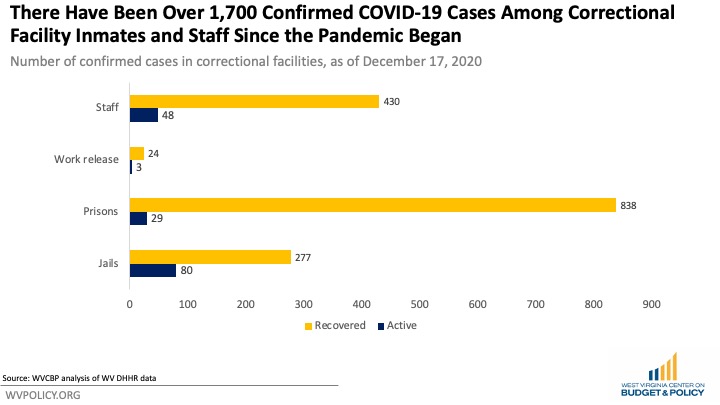As COVID-19 cases rise across the country and throughout the state, West Virginia’s correctional facilities continue to be at heightened risk of outbreaks. Outbreaks are particularly concerning in these facilities because incarcerated people tend to have both more health challenges and less access to quality medical care than the general populace. With the state entering Phase 1 of its vaccination program, health officials should prioritize vaccinating incarcerated populations in addition to staff to ensure that these vulnerable populations are protected. Further, the state should work to safely reduce the incarcerated population by making heavier use of alternatives to incarceration.
As of December 17, five of the 10 regional jails in the state had at least one COVID-19 case, and there have been five confirmed COVID-19 deaths among incarcerated people in the state’s jails and prisons. Despite this, the regional jail population is more than 31 percent over capacity.

Outbreaks in correctional facilities aren’t just dangerous for incarcerated people and staff. With staff returning to their homes at the end of every shift and the cyclical nature of regional jail admissions and releases, an outbreak in a facility can quickly spread to the surrounding community. This can be disastrous in rural areas, which tend to have less health care infrastructure and poorer health outcomes.
The Prison Policy Initiative recently released a report that found that COVID-19 cases grew quickly during the summer in non-metro or rural counties that had relatively high incarceration rates, and that in West Virginia, incarceration contributed to an additional 25.7 cases per 100,000 residents through August 1. With the incarcerated population remaining flat even as COVID-19 cases rise in the state, it’s likely incarceration is having an even larger impact now than during the study period.
West Virginia’s regional jails statewide are currently filled to 131 percent of combined capacity, which is a dangerously overcrowded state to be in at any time, but particularly so during a pandemic. A staggering 42 percent of these jail inmates are being held pretrial, meaning that they haven’t been convicted of a crime, yet they remain in jail. Another 39 percent are under Division of Corrections and Rehabilitation (DCR) supervision, meaning that they should be incarcerated in the state’s prisons — which are not facing the same capacity strains — rather than in jail custody.
Corrections officials, law enforcement, magistrates, and prosecutors can work together to lower the jail population, which will reduce the chance of COVID-19 spread within jails, and in effect protect both jail communities and the broader communities where jails are located.
House Bill 2419, the bail reform bill, provides a mechanism for officials to release nonviolent defendants pretrial without cash bail. In addition to reducing COVID-19 spread, this would allow defendants to continue their lives as normal while their legal process proceeds, rather than remaining incarcerated throughout this process, which puts them at risk of losing their employment and falling behind on rent.
The state’s prison population has been dropping since March, in contrast to the jail population. However, there are still people incarcerated in prisons who should be released.
Due to lack of transitional or permanent housing for certain groups of incarcerated individuals, such as people with skilled nursing needs, there are likely hundreds of people who have served their time and would be released from prison if they had an approved home plan. Creating a home plan can understandably be difficult during a pandemic, when job opportunities are scarce and many social services are under-resourced. Be that as it may, amid a pandemic that is deadlier for prisoners than the general population, corrections officials and policymakers should prioritize working with community leaders to find suitable housing for people incarcerated in prisons who are otherwise eligible for release.
This barrier to reentry also underscores the need for more support for returning citizens in the state. Reentry services are simultaneously understudied and underfunded, but it’s evident that housing support, job training, education, health care, and substance use treatment are important for reducing recidivism and giving formerly incarcerated people the strongest opportunities to succeed. The governor should consider using money from the CARES Act to fund reentry services, including safe and supportive housing, to allow for more people to be released from prisons.
One in five prisoners in the United States has tested positive for COVID-19, a rate four times higher than that of the general population. In addition to being deadly for incarcerated individuals, outbreaks in facilities in West Virginia and across the country have been proven to lead to wider community spread outside of the facilities. As such, in order to protect the general public, it is critical that West Virginia officials make a concerted effort to protect incarcerated peoples and corrections staff by prioritizing COVID-19 vaccinations for both of these populations and continuing the decarceration strategies that were implemented at the start of the pandemic.